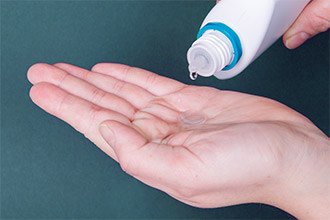Enter the contact lens care aisle of most supermarkets and drugstores, and you'll find a confusing array of products.
Though daunting, it's essential to understand lens care: Not caring for your contact lenses properly can lead to a variety of eye infections, including some that cause blindness.
Actually, contact lens care is easier than ever. One-bottle care systems and disposable contact lenses mean that proper lens care involves much less time, expense and trouble than it did years ago.
Before we get started, understand that you should not switch care regimens without asking your eye doctor first. Some products are not compatible with each other, or with certain contact lenses. Using incompatible products can ruin your contact lenses or harm your eyes.
To make sense of all the bottles and boxes, it helps to know what steps are required to care for soft contacts.
It's particularly important to follow guidelines for safe handling of soft contact lenses in light of recent outbreaks of serious fungal eye infections associated with a popular (now discontinued) brand of contact lens cleaning/disinfecting solution.
he Basics Of Soft Contact Lens Care: Clean, Rinse And Disinfect

To clean contacts with a multipurpose solution, place the lens in the palm of your hand, apply a generous amount of solution and gently rub the lens against your palm with your pointer finger, using a back-and-forth (not circular) motion.
- Wash your hands so that you don't transfer dirt and germs to your eye. Try to avoid moisturizing soaps, as they are not good for contact lenses. Dry your hands with a lint-free towel.
- Remove one lens and clean it with the recommended solution. Cleaning removes eye-produced buildup, cosmetics and other debris that impairs lens comfort. The
FDArecommends that you rubthe lens in the palm of your hand with a few drops of solution, even if you are using a "no-rub" product.
- Rinse the lens again to remove the loosened debris, making sure to take as long as the package directs: Rinsing is an important step.
- Place the lens in your clean lens case or lens holder and fill with fresh solution; don't "top off" your old solution. Disinfecting kills microorganisms on the lens. Disinfection time varies from product to product; check the package for details.
- Repeat steps two through four for your other lens.
Beyond Clean, Rinse And Disinfect
Protein. Depending on what kind of contact lenses you wear and how much protein
your eyes deposit on your contacts, your doctor may recommend you use a product for protein removal.
While cleaning them does remove some protein, it can still build up on your lenses and make them uncomfortable. That's why the longer you wear lenses before replacing them, the more likely you are to need a protein remover.
For example, if you wear disposables, you probably won't need one; but if you wear the kind of lenses that are replaced only once or twice a year, you definitely will. Products for removing protein include enzymatic cleaner and daily protein removal liquids.
Eye dryness and irritation. Use contact lens eye drops to lubricate your eyes and rewet your lenses.
Eye sensitivity and allergies. A small percentage of lens wearers develop an eye allergy to the chemicals present in contact lens solutions. If this is the case with you, you don't need an additional product: You just need to switch products to those marked "preservative-free."
Source:
